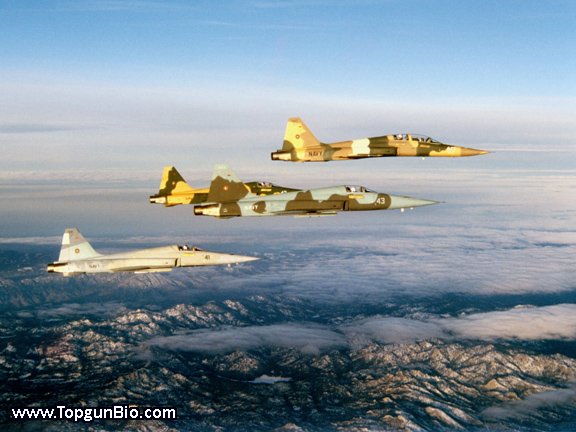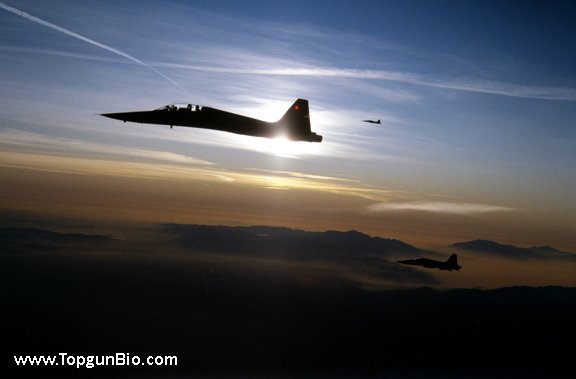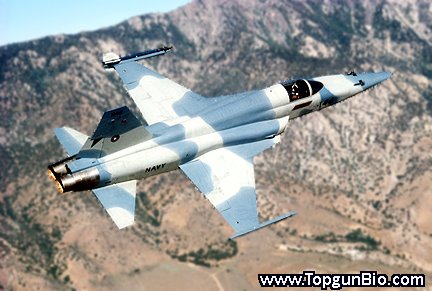Topgun Det to China Lake - 1986
This story was planned for one of the later parts of TOPGUN DAYS, so it doesn't include a lot of explanations; things have already been explained. But it gives a sense of what instructors did during a day of the Topgun class.
“Miramar Tower, Topgun 50. Four F-5s for takeoff; split the duals.”
It was 6:59 AM. Like many airfields Miramar didn’t allow aircraft to takeoff until 7:00, to minimize the noise impact on the surrounding community.
The Topgun class fighters were headed to China Lake and we instructors were taking four F-5s and four A-4s to provide the air-to-air opposition. I was Dash Two in the flight of F-5s.
The China Lake trip meant two full days of intense flying so Instructors always wanted to go. But based on the number of planes we could take, each of us went roughly half the time, or three times per year. We would be simulating fighters defending their homeland, so we pre-positioned at NAS China Lake for the first event. That meant an early brief for the 200-mile flight up from Miramar, but since it was just an administrative flight the brief was short. It also gave us a lot of flexibility in terms of launching a lot of bogeys against the class.
This time of year and this time of day it was cold outside, so we sat in the hold short area with our canopies down. I was finally waking up. I had heard Don Henley’s “Boys of Summer” on the radio driving in – it was a favorite among Instructors and the tune replayed in my mind, apropos as the dusty orange sunrise lit the gray overcast.
Miramar Tower replied to lead's request: “Topgun 50 flight, cleared for takeoff.” We had the field to ourselves this morning.
The F-5Fs took the right runway, the single-seat E-models took the left. We went through our pre-takeoff checks, looked at each other’s aircraft, and gave the thumbs-up. 50’s pilot put his head down and held the brakes, advanced his throttles, raised his head, and we were off.
It was overcast and gray as we took off, and actually seemed to get darker as we climbed out over the ocean. On some of these flights we got together with the A-4s for a giant formation, but today we just went up as four F-5s. We flew northwest off the coast then turned right and flew over Los Angeles to head toward China Lake. The city below looked enormous, you can't hide that, but unusually muted during the transition from night to day, the landscape dotted with just a few lights. Five Topgun F-5s cruise near China Lake (the four in the photo plus the one I was in).
Five Topgun F-5s cruise near China Lake (the four in the photo plus the one I was in).
A few minutes later Topgun 50 contacted China Lake and announced our arrival, telling them we would be flying in the uncontrolled areas for about 20 minutes. We could have landed at the field 30 minutes after leaving Miramar, our fuel tanks more than ½ full. But there was no hurry: the class was just starting their tactical brief back in Classroom 1 and wouldn’t be up for a couple more hours, so we had planned to do some flying over the Sierra Nevada mountains. 50’s pilot gave the speed-brakes signal (similar to the hand signal people use when they imitate someone talking, only he held his hand facing backward), then popped his speed brakes and the flight descended from our enroute altitude of 21,000’. He aimed for a valley west of the naval air station.
We all kept a good lookout for other aircraft as we descended. The likelihood of any in this airspace at this time of the morning was low, but everyone wanted to be the first to see one. There were none. As we descended to a few thousand feet above the ground, the lead pilot took a shallower dive angle, gently bringing us to an altitude of just 1,000’ above the ground. We stabilized there, advanced the throttles, then descended further.

It was about 7:25. In contrast to the flight up, the sky was clear and the sun was bright even though it was still near the horizon. We flew low over the radiant white surface of a flat dry lake – the same one that Jaws and I had flown over a few years before as Topgun students. This time no one was chasing me. To my right, the two F-5Es surged forward to fly alongside us. We had all switched to a private squadron frequency on our radios, and when we saw a small cabin ahead someone said on the radio, “Wake up call.”
The A-4 flight lead came up on our frequency to say they were a few miles behind us. The F-5s made a sweeping left turn to head west, directly toward the mountains that rose sharply to define this valley. The two F-5E pilots wanted to look at a specific area, so 50’s pilot detached them from the formation. They turning south, lit burner, and climbed, disappearing into the mountains. The A-4s said they would work in a different area. That left the two F-5Fs to ourselves; we climbed steeply out of the valley and leveled off above the snow-covered terrain.
Topgun 50 said he was just going to fly around and look at the snow cover, and we said that sounded fine to us. Two sleek fighters roamed above the craggy terrain and snow, just sightseeing. The radio occasionally carried comments from the A-4s or the F-5Es, but they were brief and rare. Everyone was flying, not talking. My pilot and I didn’t say anything on the ICS.
We cruised and banked over that remote portion of the Sierra Nevadas, looking at nothing in particular but enjoying the fabulous view of everything. 
After ten minutes, 50 gave us a fuel check signal and we all realized it was time to land. The RIO signaled to switch the radio to China Lake Tower. We made a descending and accelerating left turn to set us up for the break and landed about 8:00.
We walked to the small cafe near the flight line and had egg sandwiches for breakfast. The F-5E pilots had gotten there ahead of us and the A-4 pilots came in after. Everyone was awake now; ten Topgun Instructors who had just enjoyed one of the perks of the job and were looking forward to a full day of pure work. We talked about the snow cover and remote cabins we had just seen, as well as how the jets were doing. Meanwhile our small ground crew was preparing the bandits for the morning mission.
We finished our sandwiches and went to a briefing area for the mission brief: launch times, control frequency, formations, altitudes, weapons load, maneuvers, areas of emphasis for these students, and dozens of other details. I had done this for two years and easily absorbed each comment. The new pilots paid close attention and then flew as wingmen anyway, but they were coming along quickly.
After takeoff we flew to our stations in minutes, then waited for the fighters. Some of us orbited in forward positions and were either killed quickly or survived and engaged the fighters. Others orbited behind, to attack as a second wave. We didn’t worry about the simulated radars and missiles on the Echo Range below – they were all aimed at the class fighters. When “knock it off” was called we reset and made another run. We had to plan our timing and presentation so that our ten aircraft could challenge four sections of fighters. The first two fighters reached bingo and left the range for China Lake, and the second section reported on station and ready. The third section would be over LA and the fourth had probably just cleared the coast off San Diego.
The bandits that launched first worked at least two sections before we were at bingo. A few stayed for the third section. Other bandits waited on deck and sequenced in to challenge Topgun 5 and 6, and then Topgun 7 and 8. It was a large complex exercise. It was also a great way to spend an hour!
In waves we landed and debriefed, then went to lunch.
We sent a single bandit representative to the afternoon brief so the class fighters wouldn't know how many aircraft they would be facing. When the rep came back we completed the bandit mission brief and walked out to the jets. The fighters were given time to discuss their gameplans and review tactics, and it took them longer to start their aircraft, which meant we had about 45 minutes before the first bandit launch. It was now sunny and reasonably warm so everyone climbed up on their plane to relax. A few guys actually took the opportunity to nap. I was reading The First Deadly Sin by Lawrence Sanders and was so engrossed in it that I had tucked it in my g-suit pocket for this trip. I sat on the wing of my jet, flight suit pulled down around my waist and my light blue Topgun t-shirt off to catch some rays, and read for more than 20 minutes before we decided to start. By that time the fighters were starting their engines so it got loud anyway.
The afternoon flight was another great session of flying and fighting. That evening the students and Instructors went to dinner in a huge gaggle, then went out for beers in the tiny town of Ridgecrest, California.
The next day we completed three flights, managing our fuel on the last one so everyone could fly back to Miramar. At only two days, the China Lake detachment was short. But with six great flights it was a sought-after prize.
An afterthought: I have no photos of Topgun aircraft at the China Lake airfield. It was a test and evaluation site, and they were serious about security. I pulled my camera out of the cockpit the first time I went there, and within a few minutes a Security truck pulled up and said to put it away or lose the film. I put it away.
Questions or comments? Contact: Bio@TopgunBio.com
